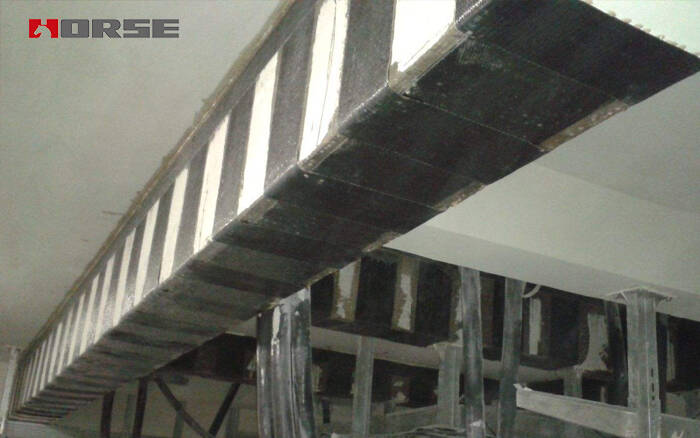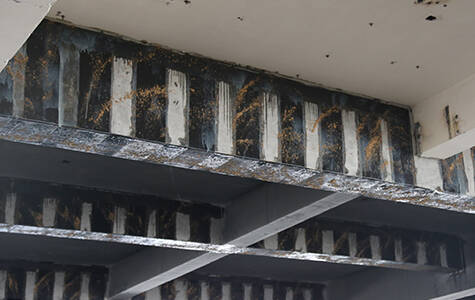Solutions
Horse Construction offers full range of structural strengthening materials with technical supports, documentation supports, products supports, project supports.
Reinforced And Armed Concrete Beams With Carbon Fiber Composites

Current status of infrastructure
Infrastructure is a huge network of roads, buildings and bridges, which must meet the economic and social needs of mankind. The current state of this infrastructure is worrying. Indeed, several of them showed obvious signs of deterioration. There are many possible reasons: material aging, corrosion, increased road overload, improper design, construction errors or even a combination of these factors. The need to solve this problem provides only two possibilities: reconstruction or repair. However, strengthening certain structural elements is usually much cheaper than performing a complete reconstruction of the structure.
Different techniques for external reinforcement of reinforced concrete structures have emerged.
One of the first methods used is to bond the steel element to the surface under stress. The emergence of fiber-reinforced polymers in civil engineering practice and the difficulties encountered in the use of steel plates have led to the emergence of FRP (fiber-reinforced polymers) in repair practices. FRP has many advantages because they have a high strength-to-weight ratio and will not corrode. Therefore, FRP can not only be used for bending and shear strengthening of reinforced concrete beams, but also for closing stable or damaged structural columns.
Composite material performance
RP fiber-reinforced plastics are composed of two or more different materials, which are combined on a macro scale to produce products with more characteristics than their individual components. FRP is a combination of high-strength fibers (glass fiber, carbon fiber and aramid fiber) in the matrix (polyester fiber, vinyl ester, epoxy resin or other fibers). The material thus obtained is heterogeneous and anisotropic. The fibers provide mechanical strength, and the matrix holds the fibers together, protects the fibers and transfers the load to the fibers through shear.
FRP board is a laminate (called laminate) composed of many layers. The ply is a layer of fibers or woven fibers impregnated in the matrix. When the plies are stacked together in a combination of directions defined according to the required mechanical properties, the product is called a laminate.
FRP is manufactured in different forms, such as sheets, strips or profiles. Each of these products is suitable for very specific uses in the engineering field. The most important feature of FRP is its high strength-to-weight ratio. A person can easily produce FRP with a tensile strength greater than steel, and this tensile strength is equivalent to less than 10% of steel.

Application of composite materials in civil engineering construction
Use FRP for structural repair
Many buildings are being constructed, many of which are approaching their useful lives. This will affect buildings and reinforced concrete bridges. Chemical attack, mechanical shock and continuous increase in user load will accelerate the degradation of these structures. Therefore, for some of these bridges, reconstruction should be considered. However, the budget cuts implemented by our government are forcing us to find more economical and sustainable solutions. Despite the limited number of examples, composite materials can still provide an effective method.
Initially, FRP plates made of carbon or glass were used as anti-corrosion materials. Their advantage is that they eliminate the problem of length limitation, because they can a priori any size. In addition, when they are glued to the outer surface of reinforced concrete members in the form of plates, they have proven to be very effective in increasing bending and shear strength. Therefore, multiple reinforcements were carried out on beams, walls, slabs and reinforced concrete columns
Later, for the first time, a large number of composite materials were used to repair the bridge. The use of composite materials for repair and reinforcement has become an alternative solution that advocates being as effective as steel.
You can find anything here you are in need of, have a trust trying on these products, you will find the big difference after that.

High strength, unidirectional carbon fiber wrap pre-saturated to form a carbon fiber reinforced polymer (CFRP) wrap used to strengthen structural concrete elements.

High strength, unidirectional carbon fiber fabric pre-saturated to form a carbon fiber reinforced polymer (CFRP) fabric used to strengthen structural concrete elements.

High strength, unidirectional carbon fiber sheet pre-saturated to form a carbon fiber reinforced polymer (CFRP) sheet used to strengthen structural concrete elements.